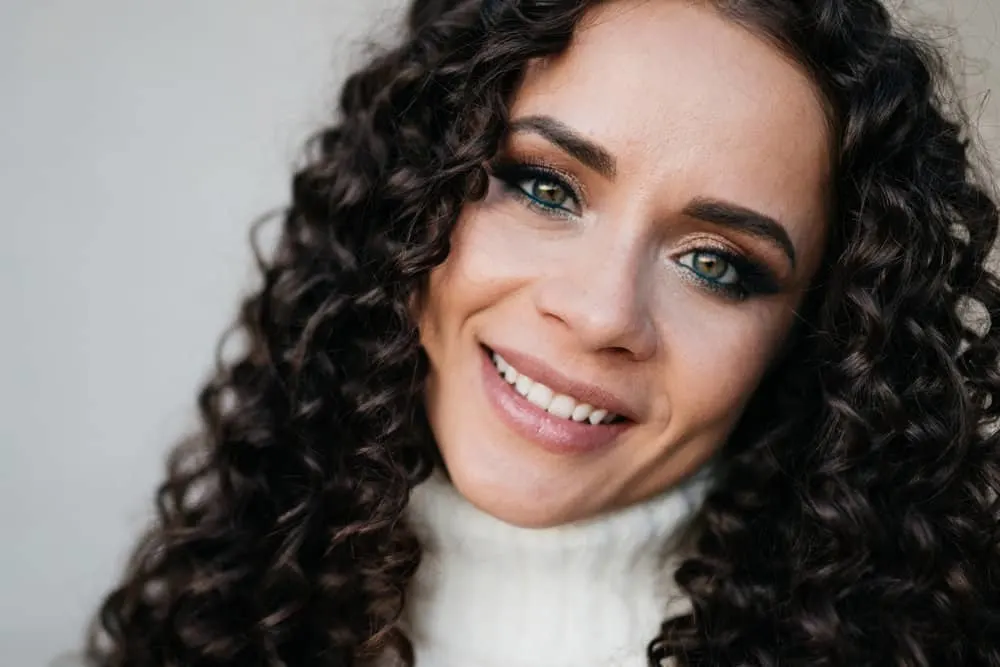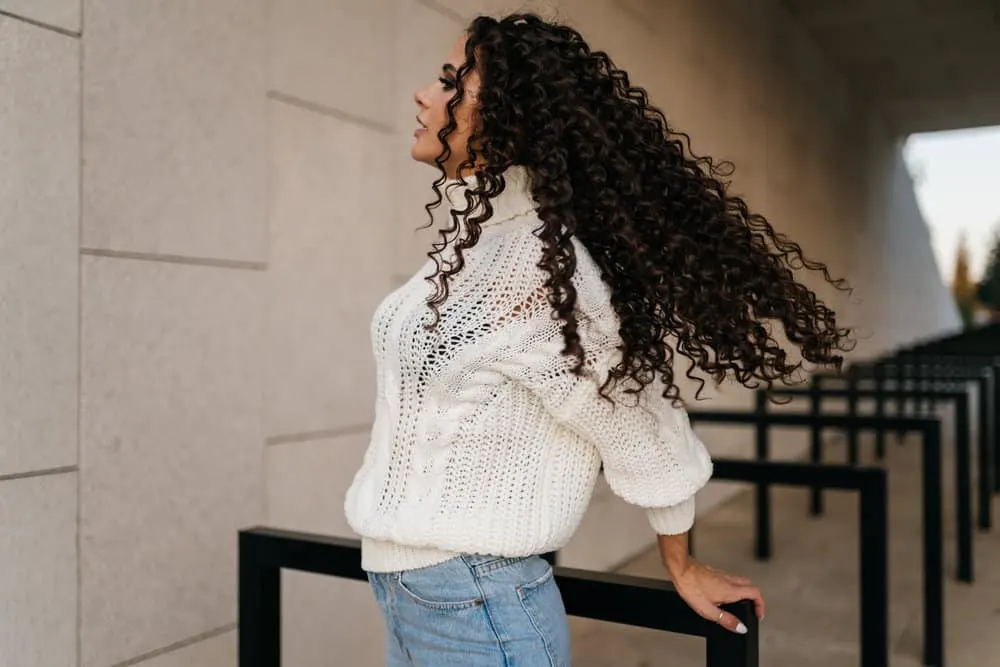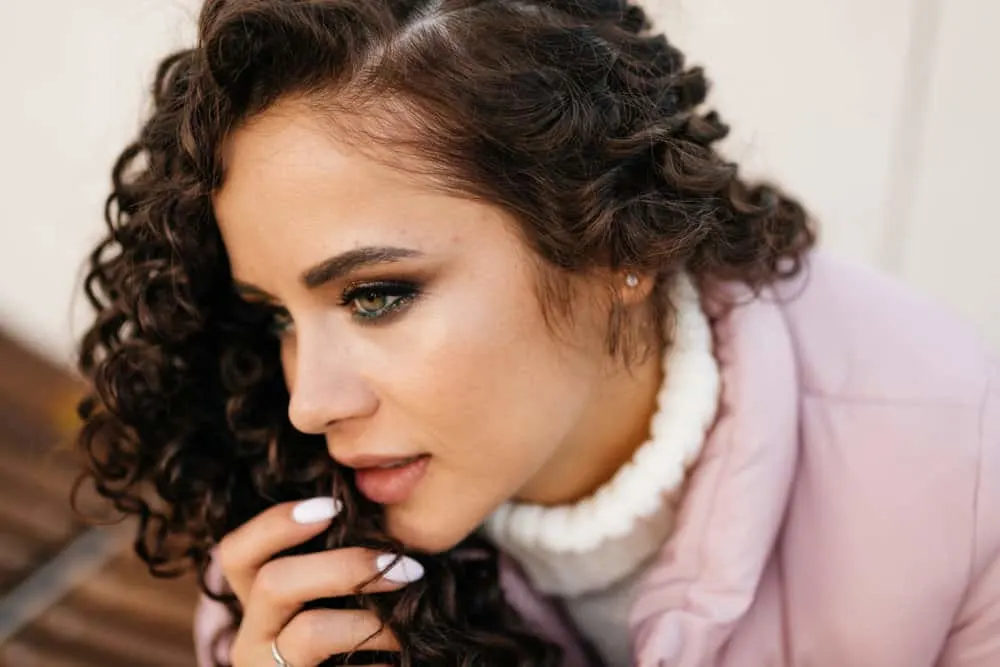
When most people are ready to overhaul their look, they think about haircuts, extensions, or switching up their color, but what about changing your hair texture?
If you’ve ever wished for gorgeous curls and stunning waves, you may have considered getting a perm.
After doing some research, you probably want to know just how much your texture-changing service will cost. So in this article, we’ll dive into how much a perm costs and everything else you’ll need to know about them. Let’s jump right in!
Table of Contents
How Much Does a Perm Cost?
As with all hair services, the costs of perms vary by salon. However, a perm will typically cost between $40 and $200, though some perm types cost more. Remember, your actual perm may cost more or less than the range we’ve included.
Perm prices differ depending on a number of factors, including:
- The length and thickness of your hair – The longer and thicker your hair is, the more you should expect to pay for your perm. The increased price accounts for the additional time the stylist will need to spend on your hair.
- The type of perm you choose – There are several different types of perms (which we’ll go over below), and each of them have its own nuances. But the more hair you’ll be getting permed, the more you’ll need to pay.
- Your specific salon and stylist – Certain stylists who have a ton of experience doing perms tend to charge higher for their services. And the same goes for stylists working in a big city.
- Whether you’re getting extra services, like a cut, color, or style – The base price for a perm may not include a style. In a case like that, you’ll need to pay an additional fee.

What Are the Different Types of Perms?
A perm is a chemical treatment that permanently alters the shape of your hair. Modern perms are typically used to add curls to naturally straight hair or give coily curls a looser pattern.
As we mentioned earlier, the type of perm you get will significantly impact its price.
If you’re curious about what sort of perms are available and what each one entails, we’ve got you covered! We’ll take a look at the various types of perms below.
Full Perm ($80-$100+)
A full perm is the most comprehensive type of perm available. When you get a full perm, your stylist will wrap all of your hair around perm rods and then treat it with the perm solution.
The larger the perm rods are, the bigger and fuller your curls will turn out. Once your stylist rinses the solution from your hair, you’ll have gorgeous, semi-permanent curls.

Partial Perm ($50-$80+)
Unlike full perms, partial perms are only applied to select areas. Partial perms, also called spot perms, can add volume to one section of your hair, cover up a bald spot, or create a more uniform curl pattern.
The application process is similar to a full perm, but your stylist will use fewer rods and focus on one or two small sections. This perm type is often more affordable than a full perm.
Digital Perm ($300-$500+)
A digital perm is one of the more innovative retexturizing services. It gives you natural-looking waves that last for up to one year! If you decide on a digital perm, your stylist will apply the retexturizing solution to your hair.
Then, they’ll wind small sections around heated rods.
The perm rods are connected to a digital display that monitors the rod’s temperatures, so they give you perfect results. Digital perms carry a premium price tag.
Spiral Perm ($80-$250+)
Unlike other perms, spiral perms give you tight, corkscrew-shaped curls. Spiral perms are incredibly full and voluminous, although they don’t always appear natural.
Root Perm ($25-$90+)
As the name suggests, root perms target your roots rather than the mid-lengths and ends of your hair. They’re typically used to create a natural-looking lift and give your hair more volume without changing your texture completely.

Multi-textured Perm ($50-$200+)
Instead of a uniform curl pattern, multi-textured perms give you a range of complementary curls, coils, and waves. The variety creates a more realistic look that reflects what you’d find in naturally curly hair.
In addition to looking more natural, multi-textured perms give your hair a fuller and more voluminous appearance.
Straight Perm ($50-$200 +)
Although perms are most closely associated with adding curls and waves, straight perms transform textured locks into sleek, straight strands. After your stylist soaks your hair with the perming solution, they’ll comb or flat iron it to lock in its new texture.
While the results are similar to what you’d get after a relaxer, straight perms use a different active ingredient and are slightly less damaging to your hair and skin.
Stack Perm ($60-$250+)
While most perms are done throughout the entire length of your hair, stack perms focus on the middle and bottom sections of your hair.
They’re typically reserved for people with medium to long hair that’s been cut to a single, even length. Because your roots are unprocessed, stack perms look extremely natural and grow out more slowly.
Volumizing Perm ($40-$150+)
While other perms emphasize adding a curl to your hair, volumizing perms are all about creating volume. They’re typically less expensive than other types of perms and are well-suited for various hair lengths, thicknesses, and textures.
Pin Curl Perm ($80-$100+)
A pin curl perm gives your hair subtle, natural-looking curls. The curls are halfway between a wave and a curl and are an excellent option for shorter hair lengths.

How Long Do Perms Last?
Although perms are named permanents, a perm doesn’t last forever. A professional perm should only last for about 3 to 6 months if properly cared for. After that, your perm wears off, and the treated hair will start to lose its new curl pattern.
It’s important to note that even though you’ll lose your curls, your hair has still been permanently altered. You’ll have to treat your hair like it’s been processed and disclose that to stylists before future services.
Another thing to keep in mind is that perms only affect the strands they’re applied to, so your new growth will grow as usual. You’ll have to get regular touch-ups to blend the new growth into the rest of your hair.
Do Perms Damage the Hair?
Like other texturizing services, perms can leave you with significant damage. Perm solutions contain a blend of harsh ingredients, which break down the bonds in your hair and restructure them.
So naturally, perms can leave you with structural weakness that increases your likelihood of experiencing breakage, split ends, dryness, and hair loss.
But don’t worry. There are ways you can minimize damage and keep your hair in excellent condition. We’ll tell you how to do that later in the article.

How Do I Prepare for a Perm Appointment?
If you’ve decided that you want to take the plunge and get a perm, you’re probably wondering what you can do to get ready for the service.
Preparing your hair can be the difference between gorgeous curls and frizzy, fried locks: so here are a few things you should do before your perm.
- Bring a few reference photos – Before booking your appointment, make sure you have a few clear reference photos to show your stylist. If you rely on describing the style to your stylist, there’s too much left to interpretation. Their version of loose, natural, or bouncy curls may differ from yours. By showing your stylist a picture, they’ll know exactly how to place your perm rods and can steer you toward the correct type of perm.
- Skip the bleach – Perming recently colored or lightened hair will leave you with a frizzy mess rather than a head full of perfectly defined curls. To ensure the best results possible, don’t perm over bleached hair and wait a few months after getting your hair colored.
- Get your hair cut after your perm – If you plan on getting your hair cut, it’s better to wait until you’ve already gotten your perm. Curly hair shrinks upwards and lays differently than straight hair. Additionally, cutting curly hair requires an entirely different technique than cutting straight hair. So if you want your haircut to flatter your new texture, wait until you see your new curls before committing to a cut.
- Prepare to spend some time in the salon – In addition to being pricey, perms can take a long time to complete. The exact length of time will depend on the length and thickness of your hair and the type of perm you choose. However, you should expect to spend at least a few hours in the salon.
- Get your new products ready – After you perm your hair, you’ll have to use products that work with your new texture. While you may be tempted to put off getting your post-perm products, it’s best to get them ahead of time. That way, you’ll have more than enough time to thoroughly research the different options and pick the ones that will give your strands the TLC they’ll need.
How to Take Care of Your Hair After a Perm
Perms can be expensive, so we’ll show you how to maximize your investment in this section. Following these tips will help extend the life of your new ‘do and help ensure your curls maintain that day one freshness for weeks to come.
Be Careful During the First 72 Hours
The first three days after your perm are by far the most crucial. During this period, your hair is still malleable. Manipulating and wetting it before it has a chance to set will cause your curls to fall and ruin your perm.
It may also leave you with a ton of frizz.
So to help your perm stick, don’t wet or wash your hair for the first three days. While you can still shower normally, protect your curls with a water-tight shower cap beforehand.
You should also avoid anything potentially damaging, like hot tools, hair color, and drying ingredients, while your strands adjust to their new shape. Once the 72 hours are up, your new curls should be relatively stable.
Avoid Hot Tools and Heat Styling
While hot tools aren’t the best for any type of hair, they’re especially bad for curly and chemically processed strands. Hot tools break down the bonds in your hair and can cause your new curls to straighten out and become limp.
We all know it’s best to steer clear of hot tools altogether, but there may be times where you can’t avoid them.
So try to minimize damage by using a high-quality device and keeping it on a lower heat setting. You should also apply a thermal protectant beforehand.

Try to Wash Your Hair Less Often
One of the best ways to make your perm last is to reduce the number of times you wash your hair each week.
Curly and chemically processed hair don’t need to be washed as often as straighter locks, and shampooing them too often can lead to significant dryness and breakage.
To start, try squeezing an extra day or two between your wash days.
It may take some time for your hair and scalp to adjust to your new schedule. So if you need to refresh your scalp between washes, massage some dry shampoo into your roots.
Condition Your Hair Frequently
Another way to keep your hair healthy and extend the life of your perm is to give your hair plenty of moisture. One of the best ways to do this is by deep conditioning your hair regularly.
Deep conditioners contain potent amounts of hydrating and strengthening ingredients and will help keep your strands in tip-top shape.
In addition to your weekly deep conditioning sessions, you may want to consider skipping the shampoo and co-washing your hair.
Unlike shampoo, conditioners don’t strip your hair of moisture.
Try shampooing your hair no more than once or twice a week for the best results. Then, if you have to wash your hair more often than that, opt for a co-wash or clarifying conditioner instead.

Get Regular Trims
Chemically processed hair is more fragile than virgin strands, so make sure you’re keeping your hair healthy with regular trims. Ideally, you should get your ends trimmed or dusted every 10 to 12 weeks.
If you don’t, your split ends will travel upwards. In addition to making your hair unmanageable and frizzy, skipping your monthly trims can lead to major breakage and hair loss.
Switch to Products That Are Formulated for Curly Hair
Although it’s easy to overlook, getting a perm means you’ll have to change how you approach haircare. Because curly and wavy hair has spirals and loops, your natural scalp oils aren’t able to travel down the length of your strands.
That means the ends and mid-lengths of your hair are much more likely to dry out. Products that are made for curly hair tend to include more nourishing ingredients and are less likely to dry your hair out further.

Pros and Cons of Getting a Perm
There’s no doubt about it; perms are a major commitment. So naturally, you’ll need to take great care in deciding whether or not you want to jump in with both feet.
It’s a lot of information to keep track of, so here are some pros and cons of getting a perm. Use this information to help you determine if they’re right for you.
Pros
- It will give you the texture you want, regardless of your natural curl pattern.
- Perms can increase your hair’s volume and body.
- Getting a perm can make styling and caring for your hair easier.
- They can even out your curl pattern and create a more cohesive texture.
Cons
- Perms are a chemical treatment and can lead to hair dryness and breakage.
- Curly hair is more likely to suffer from dryness and breakage.
- Depending on the type you choose, perms can be expensive and time-consuming.
- You may have fewer styling options than you would with virgin hair.
- Perms can require a lot of maintenance, and you’ll have to adjust your haircare regimen.
- You won’t be able to color, heat style, or wash your hair the first few days after your appointment.

Perm Dos and Don’ts
Now that you’re familiar with perms, we’d like to walk you through some best practices. By following this list of dos and don’ts, you can ensure your perm looks great and doesn’t wreck your hair.
Dos
- Do wait for a few weeks before coloring your hair.
- Do get the right haircut to highlight your new curls.
- Do switch to a silk or satin pillowcase, or cover your hair with a scarf at night.
- Do protect your hair before you swim or spend time in the sun.
- Do transition into a curly haircare routine after your perm.
- Do use a wide tooth comb to detangle your hair gently.
- Do deep condition your hair regularly.
- Do research the different types of perms to find the one that gives you the results you’re after.
Don’ts
- Don’t get your hair wet for the first 48 to 72 hours after your perm.
- Don’t pull your hair into tight hairstyles until your perm has had a few days to settle.
- Don’t heat style your hair for the first few days after you get your perm.
- Don’t get a perm if you like to straighten your hairstyle often.
- Don’t use shampoos that contain sulfates and harsh surfactants.
- Don’t brush or flatten your hair for the first two days after your perm.
- Do Perms Damage Your Hair?
- How to Get Rid of a Perm
- How Long Does a Perm Take To Do?
- What Are Digital Perms?
If you want stunning, long-lasting curls, perms are one of the best ways to go about it. However, as with all chemical treatments, perms have some significant advantages and disadvantages.
In addition to being costly and time intensive, you’ll have to rethink your approach to haircare. That said, we think the results are more than worth it. We hope this article has provided some clarity about the price of perms.
